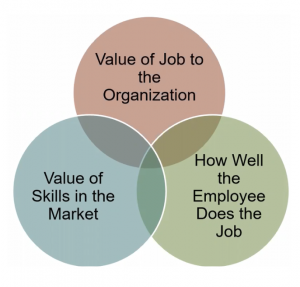How to approach pay compression
Many of our clients have been coming to us lately with a common problem: pay compression. Also known as salary or wage compression, this compensation issue arises when the pay of one or more lower-level employees is close to that of professional or management-level employees.
As organizations raise their minimum wage and market rates for certain positions increase, pay compression can be common and difficult to address. If not addressed, it can quickly lead to employee and employer frustration — and as an employer, it can definitely make you feel stuck.
What can cause pay compression?
It’s hard to trace wage compression to just one source, as it’s typically a perfect storm from a variety of factors that can affect organizations of any size, in any industry. Here are just a few examples that can lead to pay compression:
- Raising the minimum wage: Whether internally or legally mandated, minimum wage increases can at first cause an imbalance of pay scales. Raising pay for lower level workers means you need a structured approach to increasing the wages of those in the next level of management.
- Competitive labor market: It’s the natural story of supply and demand.When the demand for a particular skill set exceeds the supply of workers, you’re bound to run into issues leading to a pay imbalance if not handled properly.
- Lack of an internally equitable pay structure: We see it constantly — when there isn’t an internally equitable pay structure in place, how do you know what to do with the next levels of management after raising your minimum wage?
How can you prevent it?
Whether you’re in the thick of dealing with the effects of pay compression or you’re worried that it can affect you in the future, there are ways you can both work to prevent it and correct it. As an employer, it takes a renewed commitment to accountability, transparency, and doing right by your people.
As with most internal hurdles, it starts with awareness. It’s likely time to evaluate your current pay practices, as correcting issues like pay compression means tracing them back to the source. If you’re experiencing an imbalance in compensation, it’s time to reevaluate your current pay practices by asking yourself questions like:
- Are you only looking at market data when it comes to wage increases?
- What is the process of assessing the unique internal contributions of jobs to your organization?
- Are you being proactive versus reactive when it comes to pay?
- What isn’t working in your current approach to pay?
Our approach to compensation planning is this: We take a deep dive not only into market research, but also into the internal relationships between your jobs to get the full picture of what is needed. You need a compensation plan that is effective for you and your team both now, and into the future.
Creating an internally equitable pay structure
When you’re aiming for an internally equitable pay structure, you first need in-depth job evaluations to assess the contributions of roles in your organization, addressing the unique nature of each job exclusive of what is perceived to be the “competitive rate” in the outside labor market. From there, you can develop an internal hierarchy of jobs with defined pay grades.
Once you have that in place, you can use labor market research to establish pay ranges and a model for determining the appropriate pay for each individual based on performance.
When you’re looking at the graphic below, you’re aiming for that sweet spot in the center — that is where you find an internally equitable pay structure.
Does this mean you’ll never experience pay compression? Not exactly. But if you have a reliable plan moving forward that can minimize the chances and/or effects of it, it will help you to know exactly how to approach pay increases for optimal results. The development of an effective compensation program requires up-front investment in time and resources but makes management and up-keep less complex over time.
When you have a structure in place, you can lead confidently knowing that you can adjust and do right by your people no matter the current circumstances.





